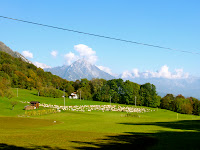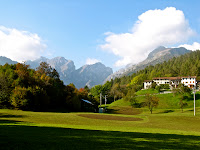I decided this was a great opportunity to be introduced to French culture and to get to see what my friend is up to this year, so I headed out Thursday to begin my adventure with my transportation plan written clearly in my notebook:
1. Train Ferrara-->Venezia
2. Bus Venezia Station-->Marco Polo Airport
3. Plane Venezia-->Lyon
4. Train Lyon-->Valence
5. Bus Valence-->Die
 |
| Lyon Airport |
The 1 1/2 hour bus ride was a great way to be introduced to the Rhône-Alpes region of France, winding through the hills in the countryside and then squeezing through the tiny streets of a few towns on the way.
 |
| Made it to DIE! |
 |
| Countryside on the bus-ride in |
I got off at the stop Cecilia said would be near the school where she worked but I couldn't seem to find her. To be completely honest, I wasn't sure if this was the right place and my French skills have pretty much disappeared in the face of all my Italian studies, so I didn't really know how to ask anyone if I was in fact at the right school. A few teachers there did note my confused face and asked me, in French, if they could help. I eeked out a couple words that I think amounted to "I look for American professor," which they somehow understood and confirmed that this was in fact the right place. I rounded the corner of the courtyard and there she was before me--a vision to my travel-weary self! As she later told me, I too was a vision to her worried-about-her-friend-lost-in-France self, so we both yelled rather loudly and ran into a hug. Cecilia later told me that she thinks that the French teacher she was with was really taken aback, as hugging is a much more intimate act in many European countries, but it wasn't the time for formalities as I thanked God to have found my destination.
Ceci introduced me to a couple of the French women that she worked with and then to another assistant that does the same thing that she does, but is Italian and teaches Italian to the kids. We all had lunch together at, of all places, an Italian café, and it was a great game of translation the whole time with Alessio speaking Italian with a little English and French, Ceci speaking English and French, and then me speaking English and Italian. Alessio left to head back to Crest, the town where he and the other assistants live and Ceci took me on a little tour of her town.
 | ||
| Cecilia in snowy Die! |
 Die is famous for a particular type of sparkling wine, Clairette, that is usually a little citrus-y and sweet, so Ceci took me to Jaillance, a company that makes and sells Clairette for a tasting. The man there let us try almost six different types, from a dryer sparkling wine called Crémant to the sweeter Clairette including a couple organic versions. After the tasting we took a bus to Crest, the nearby town where the other assistants live, to meet and have dinner with them. Once there I got to meet a couple fo them including another American, a Colombian, and a Brit. After a glass of Clairette that Ceci had brought with us we headed out to a restaurant for a little wine and a little food. This restaurant, Le Charleston, offered an interesting section that was basically variations of hashbrowns. I ended up ordering one with smoked trout and a poached egg on top--who knew this was a French was to eat? After dinner we walked around the quiet town for a bit, all lit up with Christmas lights, before heading back and spending the rest of the night at their place since they had some extra beds. Alessio ended up being back at their shared house, so I got to practice my Italian some more and even talk some politics with my new found knowledge of Italian history and current events from my classes in Ferrara. It was really just a great experience to meet all these kids from all these different backgrounds and languages living together and becoming friends.
Die is famous for a particular type of sparkling wine, Clairette, that is usually a little citrus-y and sweet, so Ceci took me to Jaillance, a company that makes and sells Clairette for a tasting. The man there let us try almost six different types, from a dryer sparkling wine called Crémant to the sweeter Clairette including a couple organic versions. After the tasting we took a bus to Crest, the nearby town where the other assistants live, to meet and have dinner with them. Once there I got to meet a couple fo them including another American, a Colombian, and a Brit. After a glass of Clairette that Ceci had brought with us we headed out to a restaurant for a little wine and a little food. This restaurant, Le Charleston, offered an interesting section that was basically variations of hashbrowns. I ended up ordering one with smoked trout and a poached egg on top--who knew this was a French was to eat? After dinner we walked around the quiet town for a bit, all lit up with Christmas lights, before heading back and spending the rest of the night at their place since they had some extra beds. Alessio ended up being back at their shared house, so I got to practice my Italian some more and even talk some politics with my new found knowledge of Italian history and current events from my classes in Ferrara. It was really just a great experience to meet all these kids from all these different backgrounds and languages living together and becoming friends.
The next morning Ceci and I said goodbye and walked around Crest for a bit, just catching their Saturday food market with the streets lined with tables of vegetables, mussels and oysters, roasting chickens. It was another great opportunity to see the similarities and differences between French culture and Italian culture in this weekend market. We each bought lunch, a piece of quiche for me and a sandwich for Ceci, and headed back to Die. We had enough time for showers, a quick nap, and then some shopping around Die before I had to take the last bus back to Valence at 5:30pm.
Unfortunately I had to stay a second night at a hotel alone in Valence. I really didn't want to, but the only train I could take to the airport left Valence at 9am and the earliest bus out of Die didn't get into Valence until 9:20am, so it was my only option. The difficulty of getting there and back ended up being exhausting and expensive, and, to be completely honest, made me curse France a couple times. I am still glad I was able to go and visit Ceci and see a little of her life in France, but was very very glad when I finally got back to Italy :) I was greated by some wonderful Christmas lights in Ferrara, including the beautiful Christmas tree in the center of town! I just have two more final exams and some Christmas shopping to do before heading back to Colorado in one week!













































